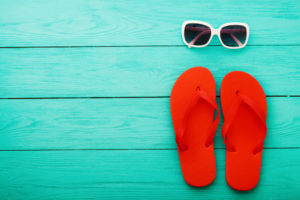 While these open comfy sandals may be your favorite footwear, who knew that (without proper support) flip flops and foot health could be a contradiction in terms? If you’ve worn flip flops for years, this post may contain a few surprises.
While these open comfy sandals may be your favorite footwear, who knew that (without proper support) flip flops and foot health could be a contradiction in terms? If you’ve worn flip flops for years, this post may contain a few surprises.
Flip Flops: There’s a History
The narrative of flip flops goes back quite a ways, originally they were made B.C. from rawhide and papyrus. The Japanese created a woven version of these open sandals in the 1920s, and their new trend spread easily through the South Pacific. Zoris were comfortable for beach walks, and inexpensive, and also solved the problem of getting sand out of your shoes! New Zealand reconstructed the zoris with plastic and rubber and was responsible for making them so universally popular.
The rubber sandal and local Hawaiian tradition became inextricable once they arrived there along with the Japanese settlers in the 1940s. The ‘rubbah slippah’ became ingrained in the local Hawaiian culture – to the point where it symbolizes the laid-back character and humility of its people; so much so that other footwear is rarely worn. Typically you’ll see ‘slippers’ grouped around front doors, showing the respect of entering homes without tracking dirt or mud inside.
What’s so great about Flip Flops?
We love flip flops because they’re easy to slip into and out of; they fit in your purse or backpack for quick changes at the pool or beach; you can just kick them off to go inside without messing up a clean floor. And more, our feet feel great with the warmth of the sun on them – free from the confines of leather enclosures with laces, buckles or snaps to keep them in place.
As to flip flops and foot health, there are even a few medical reasons for owning them. When used in communal areas (pools, showers, etc.) they protect you from bacteria and fungus exposure. The same goes for outdoor use, as they allow your feet to air out; minimizing vulnerability to such risks. They are also perfect for summer days to shield your feet from hot pavement, asphalt and such.
So, what’s bad about Flip Flops?
The other take on flip flops and foot health, as one WebMD post explains, “Unlike sturdy shoes, flip-flops aren’t good for extensive walking because they offer no arch support, heel cushioning, or shock absorption, according to the American Podiatric Medical Association (APMA). Wearers can suffer tendinitis or foot pain due to lack of arch support, and even sprained ankles if they trip.”
Doctors and surgeons alike will tell you that running or jumping in flip flops can elicit sprains, fractures or ligament injuries. Flips flops can be the precursor to injuries such as stubbing your toes, dropping something accidentally on your foot (like a can of soup you reached for in the kitchen cupboard). For diabetics, any foot injury can even mean amputation!
Flip flops are meant for walking on flat surfaces, although wearing them while doing yard work can be dangerous. Whether you’re mowing, using a shovel, brandishing a weed eater, or power washing – exposed feet are ripe for cuts, scrapes and puncture wounds. And let’s not forget insects and snake bites! Work boots or closed shoes are strongly recommended.
Is there a way to wear them well?
- Whether you’re planning a hike or climb, or a nice slow walk from one end of town to the other – athletic shoes, not flip flops, are the right choice.
- Purchase flip flops with built-in orthotic support (Dr. Auger recommends Vionics brand), because eventually your feet are in for uncomfortable afflictions or severely painful debilities if you wear flip flops consistently.
- Another alternative is clogs, preferably waterproof with lightweight tops.

